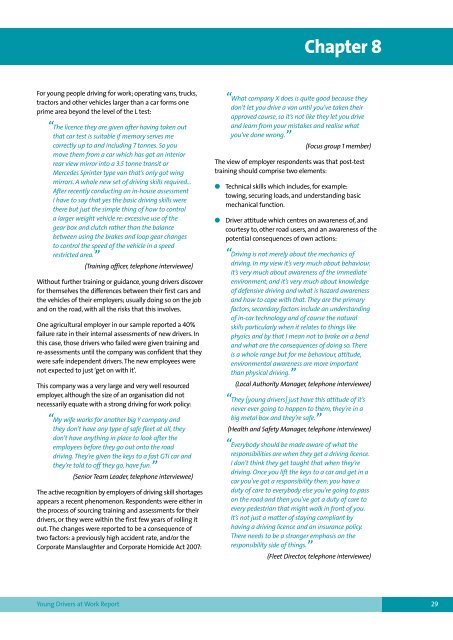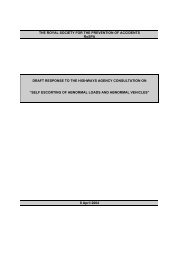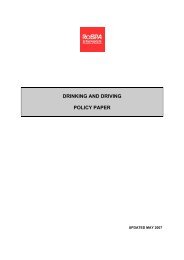RoSPA Young Drivers at Work Report
RoSPA Young Drivers at Work Report
RoSPA Young Drivers at Work Report
You also want an ePaper? Increase the reach of your titles
YUMPU automatically turns print PDFs into web optimized ePapers that Google loves.
Chapter 8<br />
For young people driving for work; oper<strong>at</strong>ing vans, trucks,<br />
tractors and other vehicles larger than a car forms one<br />
prime area beyond the level of the L test:<br />
“The licence they are given after having taken out<br />
th<strong>at</strong> car test is suitable if memory serves me<br />
correctly up to and including 7 tonnes. So you<br />
move them from a car which has got an interior<br />
rear view mirror into a 3.5 tonne transit or<br />
Mercedes Sprinter type van th<strong>at</strong>’s only got wing<br />
mirrors. A whole new set of driving skills required...<br />
After recently conducting an in-house assessment<br />
I have to say th<strong>at</strong> yes the basic driving skills were<br />
there but just the simple thing of how to control<br />
a larger weight vehicle re: excessive use of the<br />
gear box and clutch r<strong>at</strong>her than the balance<br />
between using the brakes and loop gear changes<br />
to control the speed of the vehicle in a speed<br />
restricted area. ”<br />
(Training officer, telephone interviewee)<br />
Without further training or guidance, young drivers discover<br />
for themselves the differences between their first cars and<br />
the vehicles of their employers; usually doing so on the job<br />
and on the road, with all the risks th<strong>at</strong> this involves.<br />
One agricultural employer in our sample reported a 40%<br />
failure r<strong>at</strong>e in their internal assessments of new drivers. In<br />
this case, those drivers who failed were given training and<br />
re-assessments until the company was confident th<strong>at</strong> they<br />
were safe independent drivers. The new employees were<br />
not expected to just ‘get on with it’.<br />
This company was a very large and very well resourced<br />
employer, although the size of an organis<strong>at</strong>ion did not<br />
necessarily equ<strong>at</strong>e with a strong driving for work policy:<br />
“My wife works for another big Y company and<br />
they don’t have any type of safe fleet <strong>at</strong> all, they<br />
don’t have anything in place to look after the<br />
employees before they go out onto the road<br />
driving. They’re given the keys to a fast GTi car and<br />
they’re told to off they go, have fun. ”<br />
(Senior Team Leader, telephone interviewee)<br />
The active recognition by employers of driving skill shortages<br />
appears a recent phenomenon. Respondents were either in<br />
the process of sourcing training and assessments for their<br />
drivers, or they were within the first few years of rolling it<br />
out. The changes were reported to be a consequence of<br />
two factors: a previously high accident r<strong>at</strong>e, and/or the<br />
Corpor<strong>at</strong>e Manslaughter and Corpor<strong>at</strong>e Homicide Act 2007:<br />
“Wh<strong>at</strong> company X does is quite good because they<br />
don’t let you drive a van until you’ve taken their<br />
approved course, so it’s not like they let you drive<br />
and learn from your mistakes and realise wh<strong>at</strong><br />
you’ve done wrong. ”<br />
(Focus group 1 member)<br />
The view of employer respondents was th<strong>at</strong> post-test<br />
training should comprise two elements:<br />
●<br />
●<br />
Technical skills which includes, for example:<br />
towing, securing loads, and understanding basic<br />
mechanical function.<br />
Driver <strong>at</strong>titude which centres on awareness of, and<br />
courtesy to, other road users, and an awareness of the<br />
potential consequences of own actions:<br />
“Driving is not merely about the mechanics of<br />
driving. In my view it’s very much about behaviour,<br />
it’s very much about awareness of the immedi<strong>at</strong>e<br />
environment, and it’s very much about knowledge<br />
of defensive driving and wh<strong>at</strong> is hazard awareness<br />
and how to cope with th<strong>at</strong>. They are the primary<br />
factors, secondary factors include an understanding<br />
of in-car technology and of course the n<strong>at</strong>ural<br />
skills particularly when it rel<strong>at</strong>es to things like<br />
physics and by th<strong>at</strong> I mean not to brake on a bend<br />
and wh<strong>at</strong> are the consequences of doing so. There<br />
is a whole range but for me behaviour, <strong>at</strong>titude,<br />
environmental awareness are more important<br />
than physical driving. ”<br />
(Local Authority Manager, telephone interviewee)<br />
“They [young drivers] just have this <strong>at</strong>titude of it’s<br />
never ever going to happen to them, they’re in a<br />
big metal box and they’re safe. ”<br />
(Health and Safety Manager, telephone interviewee)<br />
“Everybody should be made aware of wh<strong>at</strong> the<br />
responsibilities are when they get a driving licence.<br />
I don’t think they get taught th<strong>at</strong> when they’re<br />
driving. Once you lift the keys to a car and get in a<br />
car you’ve got a responsibility then; you have a<br />
duty of care to everybody else you’re going to pass<br />
on the road and then you’ve got a duty of care to<br />
every pedestrian th<strong>at</strong> might walk in front of you.<br />
It’s not just a m<strong>at</strong>ter of staying compliant by<br />
having a driving licence and an insurance policy.<br />
There needs to be a stronger emphasis on the<br />
responsibility side of things. ”<br />
(Fleet Director, telephone interviewee)<br />
<strong>Young</strong> <strong>Drivers</strong> <strong>at</strong> <strong>Work</strong> <strong>Report</strong><br />
29
















